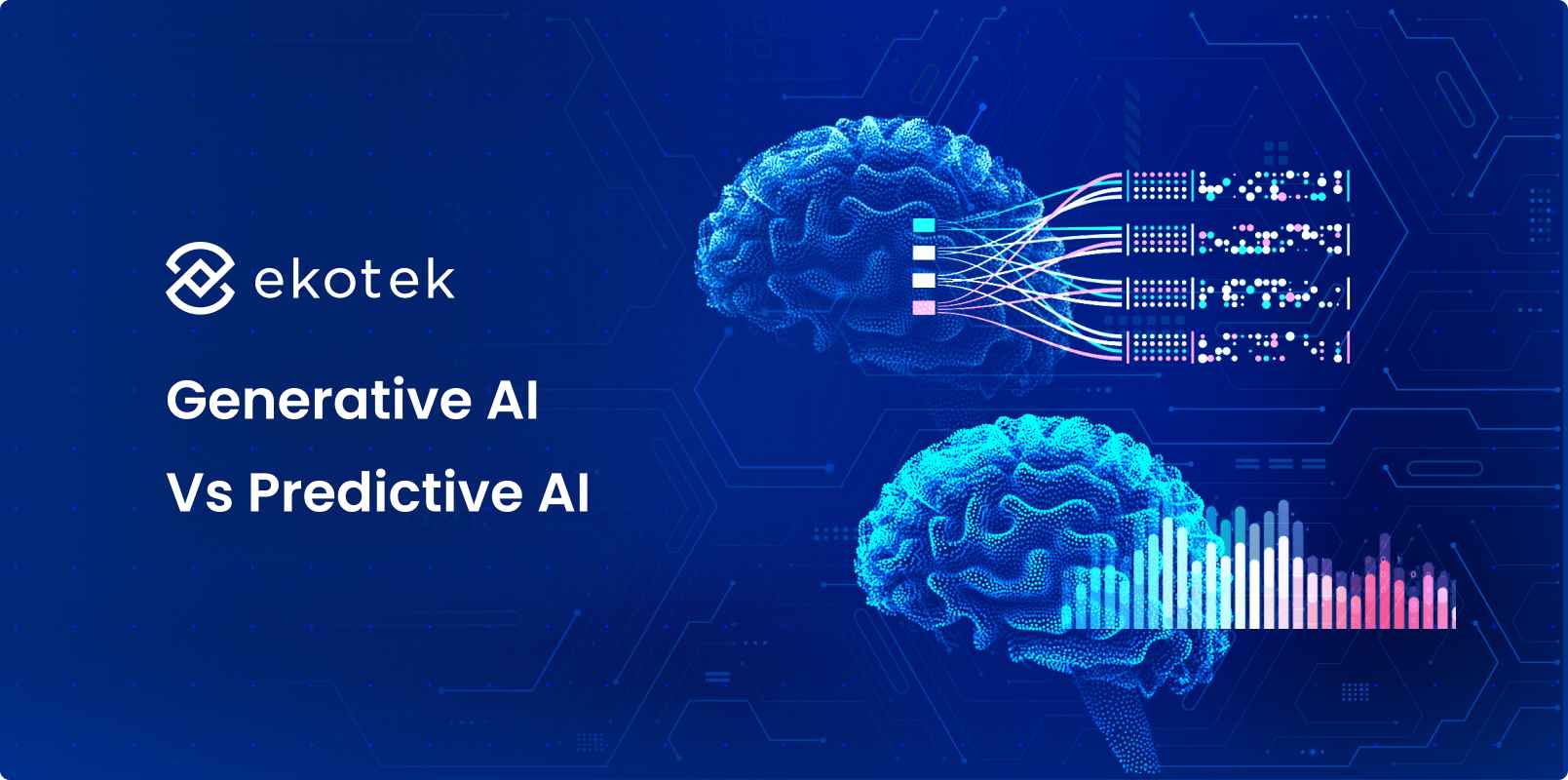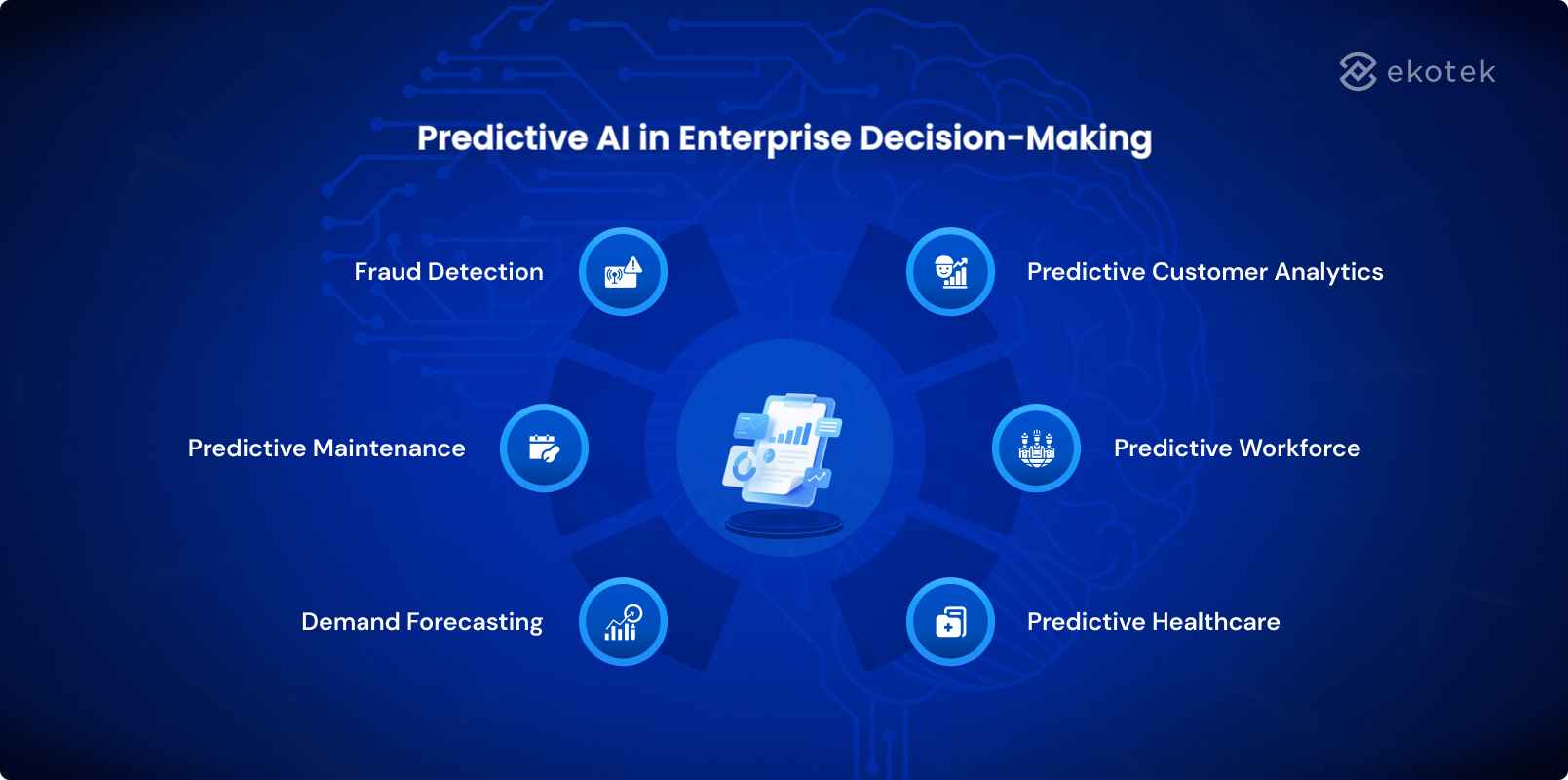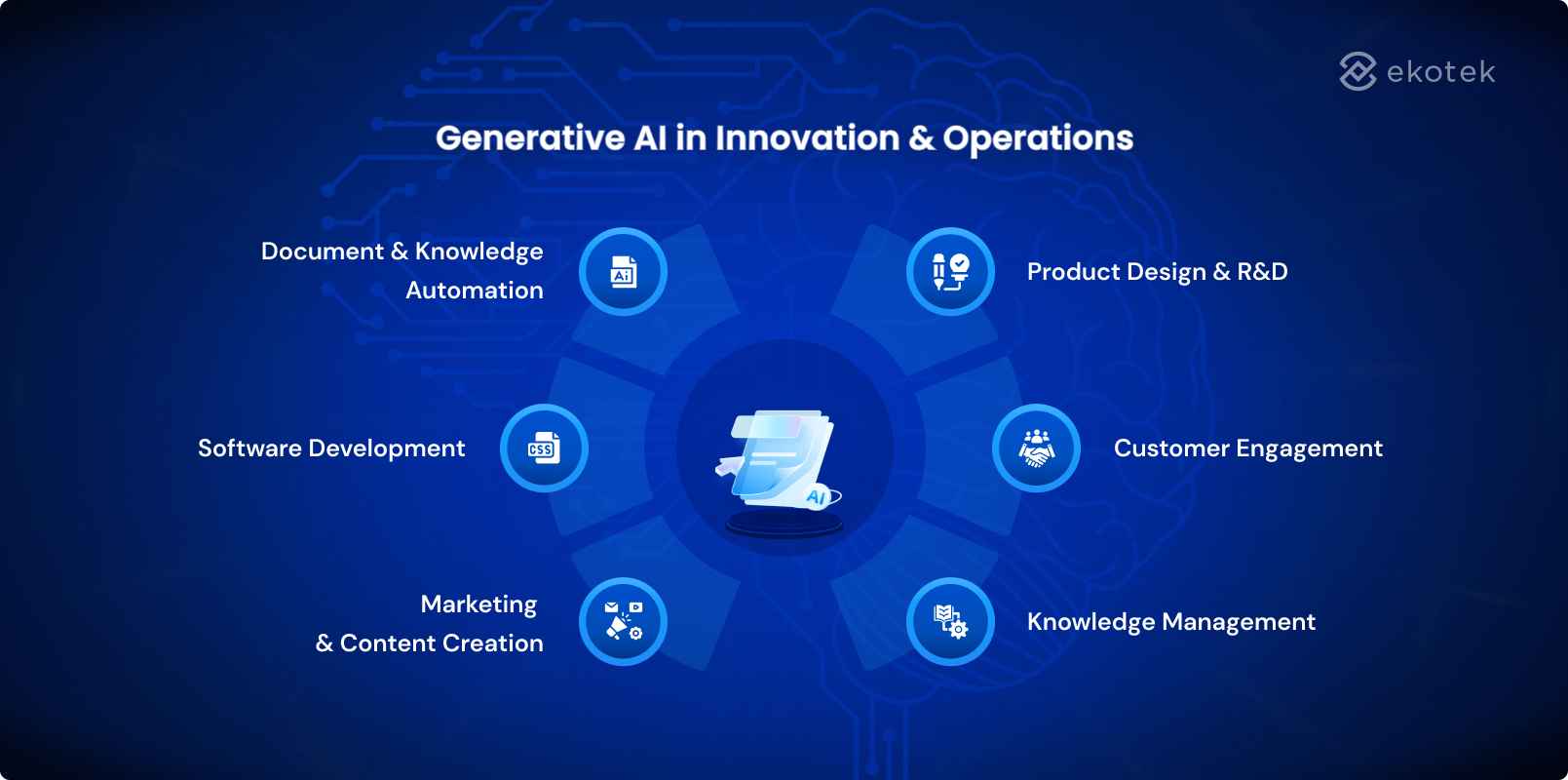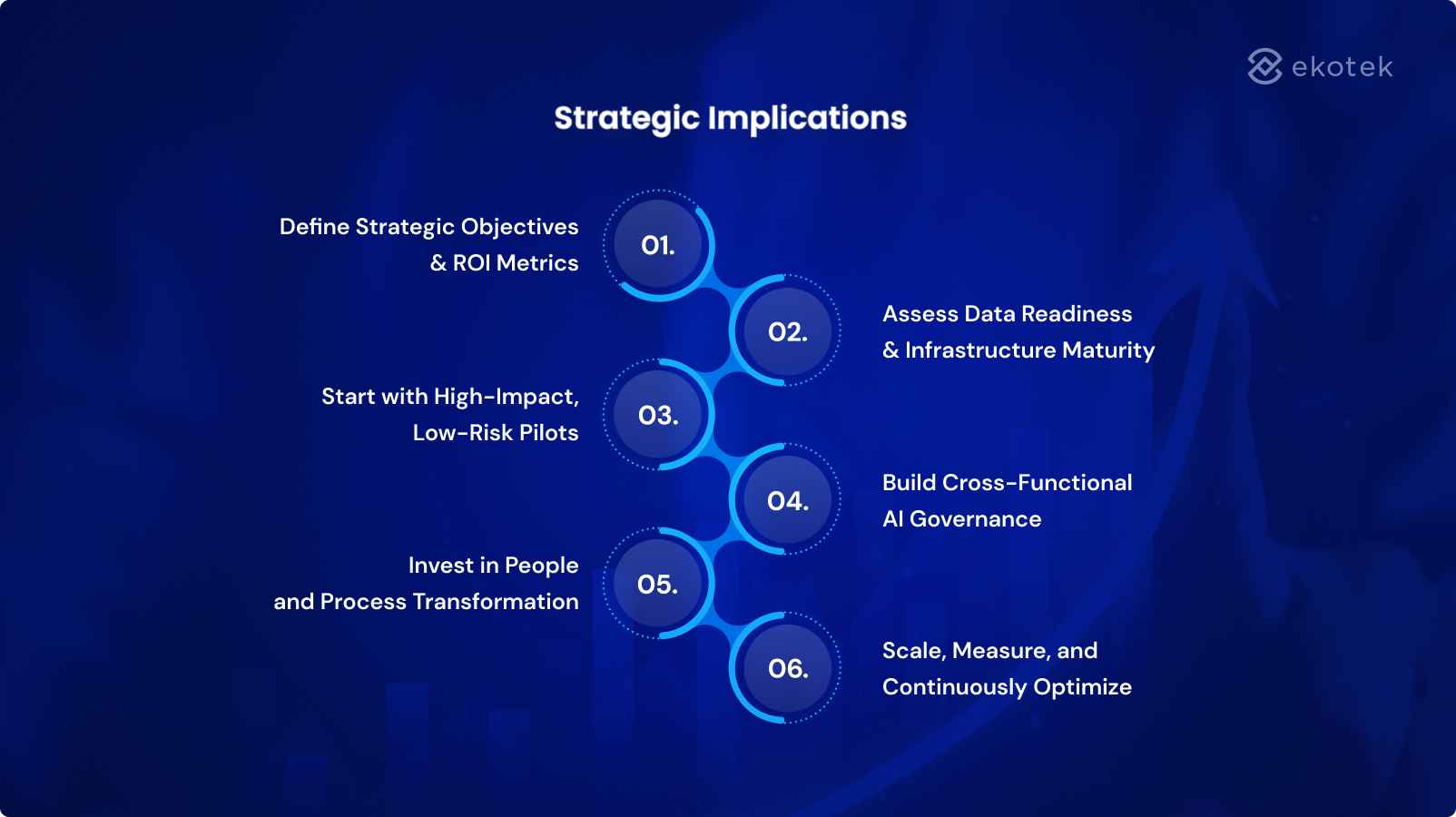
- 1
- 2
- 3
- 4
- 5
- 6
- 7
- 8
Introduction: Why AI Strategy Matters Now
In the rapidly shifting landscape of enterprise technology, making the right choice between generative AI vs predictive AI is now a strategic imperative. As digital transformation accelerates, organizations that build a robust enterprise AI strategy are seizing competitive advantage through sharper insights, faster execution, and breakthrough innovation.
Consider this: in 2024, global enterprise investments in AI grew sixfold, reaching an unprecedented $13.8 billion. For technology decision-makers, this signals an intense new era where leadership is measured not just by adopting AI, but by choosing the right type, aligning it to core business objectives, and operationalizing it securely and at scale.
Efficiency, resilience, and innovation are all on the line. Understanding the distinctions, strengths, and applications of generative versus predictive AI isn’t just an academic exercise, it’s your roadmap for maximizing ROI, staying ahead of disruption, and future-proofing your organization.
In this comprehensive guide, we’ll break down how both generative and predictive AI are reshaping the digital enterprise, enabling you to make confident, high-impact decisions that define industry leadership for 2025 and beyond.
Defining the Two Pillars of AI – Predictive AI vs Generative AI
What Is Predictive AI?
Predictive AI is the engine of foresight in modern enterprises. At its core, it leverages massive datasets and statistical models to forecast future events, assess risks, and drive decisions that improve accuracy and reduce loss. Think of predictive AI as “seeing the future”, it analyzes historical and real-time data to answer critical business questions such as “What will happen next?” or “Where are the biggest risks?”
- Methods: Pattern recognition, machine learning, deep learning, anomaly detection
- Core use case: Global banks wield predictive AI to slash fraud rates and automate risk scoring, resulting in double-digit drops in losses and manual review workload.
- Business value: Precision, regulatory compliance, cost reduction
For example, in the financial sector, leading organizations deploy predictive models to identify aberrant transaction patterns, allowing them to proactively flag and prevent fraud. In another domain, enterprise customer support teams apply predictive analytics to anticipate high-volume periods and identify which tickets need escalation, driving up productivity by 40% through AI-powered chatbots and automated triage.
What Is Generative AI?
Generative AI represents the other core pillar, moving beyond analyzing the past to creating entirely new content, ideas, and digital assets. Generative models (such as GPT, DALL·E, or enterprise transformers) are trained on vast, diverse datasets and can craft original text, images, code, contracts, and even product concepts. Here, AI acts as an “imagination engine,” enabling rapid innovation and transforming knowledge work at scale.
- Methods: Large language models (LLMs), diffusion models, transformers, creative synthesis
- Core use case: Contraktor, a legal tech leader, uses generative AI to automate contract review and generation—cutting document processing time by as much as 75%.
- Business value: Innovation velocity, process automation, creative acceleration
Generative AI’s impact is increasingly visible across industries. Real estate startup Gazelle, for example, uses it to generate custom marketing materials in seconds (down from hours), while media agency Croud leverages it to boost team productivity by up to 5X on routine creative tasks.
AI, at the enterprise scale, is thus best understood as both a lens for anticipating the future (predictive) and a toolkit for inventing what comes next (generative).
Generative AI vs Predictive AI: Key Differences for Enterprise Decision-Makers
Understanding the difference between generative AI and predictive AI is crucial for making the right investment, development, and talent decisions. Tech leaders need to know not just what each AI type can do, but how they match with specific enterprise goals.
Enterprise Comparison Table
| Aspect | Predictive AI | Generative AI |
|---|---|---|
| Main Output | Forecasts, probabilities, risk scores | New text, images, code, contracts |
| Data Requirements | Large labeled historical data | Broad, multi-modal datasets |
| Evaluation Metrics | Accuracy, precision, recall | Creativity, quality, authenticity |
| Business Role | Risk reduction, compliance, planning | Knowledge work, marketing, product dev. |
| Example Platforms | Salesforce Einstein, ServiceNow, custom ML | GPT-4, DALL·E, custom LLMs |
| Typical ROI Focus | Cost savings, error reduction | Time-to-market, productivity, revenue growth |
Interpretation for Leadership:
- Predictive AI is optimal for operational areas where reducing risk and improving accuracy are business-critical. Think fraud detection in banking, dynamic pricing in e-commerce, or supply chain forecasting in manufacturing.
⭐️ Dive into Digital transformation in banking guide
- Generative AI unlocks innovation, accelerates product launches, and scales creative or documentation-heavy work in areas such as legal, marketing, and R&D.
- Most digital enterprises will gain the greatest value by adopting both, leveraging predictive engines for risk/control and generative tools for speed and differentiation.
Quick-Select Flowchart:
- If your main KPI is cost or compliance: Start with predictive AI solutions.
- If your goal is product velocity or content scale: Prioritize generative AI platforms.
- For blended outcomes: Explore dual-strategy adoption with both AI pillars.
⭐️ Select the most suitable AI for your business, Generative AI vs Agentic AI
Business Use Cases & ROI Potential of Generative AI and Predictive AI
Enterprise success with AI hinges on matching technology to tangible, measurable outcomes. Here’s how leading organizations are realizing dramatic ROI by targeting the unique strengths of each AI approach.
Predictive AI in Enterprise Decision-Making
 Predictive AI has matured into a cornerstone of enterprise optimization, driving foresight, risk mitigation, and precision decision-making across industries. Beyond basic analytics, it delivers real-time intelligence that shapes strategic moves, operational planning, and customer engagement.
Predictive AI has matured into a cornerstone of enterprise optimization, driving foresight, risk mitigation, and precision decision-making across industries. Beyond basic analytics, it delivers real-time intelligence that shapes strategic moves, operational planning, and customer engagement.
Key Enterprise Use Cases
1. Fraud Detection & Risk Management
Global financial institutions rely on predictive algorithms to analyze millions of transactions per second, identifying anomalies and reducing fraud losses by 20-40%. Machine learning models continuously adapt to new threat patterns, improving resilience against emerging fraud vectors and ensuring regulatory compliance.
Impact: Lower financial losses, faster detection cycles, enhanced trust and compliance.
2. Predictive Maintenance & Asset Optimization
Manufacturers, logistics firms, and energy providers leverage predictive AI to forecast equipment failures before they occur. By analyzing sensor data, vibration metrics, and maintenance logs, enterprises reduce downtime by up to 50% and extend asset lifespan.
Example: Siemens and GE Digital use predictive maintenance systems to optimize turbine and factory operations, saving millions annually in operational costs.
Impact: Reduced unplanned downtime, increased asset reliability, lower maintenance overhead.
⭐️ See how manufacturing process automation helps modern manufacturers improve efficiency
3. Demand Forecasting & Supply Chain Optimization
Enterprises apply predictive modeling to forecast consumer demand, optimize inventory levels, and streamline logistics. By integrating historical sales, weather, and market data, companies like Unilever and Amazon achieve inventory accuracy improvements of 30-40%.
Impact: Improved cash flow, minimized waste, higher fulfillment rates, and reduced carrying costs.
4. Predictive Customer Analytics & Retention
Retailers and telecom companies use predictive analytics to identify customers at risk of churn and tailor proactive retention campaigns. Advanced segmentation models help marketing teams personalize offers, improving retention rates by 15–25%.
Example: Telcos like Vodafone employ predictive churn modeling to reduce customer loss and optimize acquisition spending.
Impact: Increased customer lifetime value (CLV), reduced churn, better marketing ROI.
⭐️ Digital transformation in retail is revolutionizing the industry. Learn more
5. Predictive Workforce & Operations Planning
HR and operations departments apply predictive AI to anticipate hiring needs, attrition risks, and workload patterns. By linking business forecasts with workforce analytics, companies align staffing to demand and reduce overtime or underutilization.
Impact: Workforce agility, cost efficiency, better employee experience.
6. Predictive Healthcare & Insurance Modeling
Healthcare providers and insurers use predictive models to assess patient risks, optimize treatment plans, and price insurance premiums accurately. Predictive diagnostics help detect diseases earlier, reducing hospitalization rates and costs.
Example: Mayo Clinic employs AI-driven early-detection systems to predict cardiac and chronic disease risks with 90% accuracy.
Impact: Improved patient outcomes, optimized costs, and better risk pooling.
Generative AI in Innovation & Operations
 Generative AI is redefining how enterprises create, operate, and innovate. No longer limited to creative experimentation, it now powers large-scale automation, product design, documentation, and customer engagement, accelerating the pace of transformation across industries.
Generative AI is redefining how enterprises create, operate, and innovate. No longer limited to creative experimentation, it now powers large-scale automation, product design, documentation, and customer engagement, accelerating the pace of transformation across industries.
At its core, generative AI converts data and intent into new digital artifacts, text, code, designs, or insights, turning previously manual or slow processes into automated, high-speed innovation cycles. For technology leaders, this means shorter time-to-market, higher knowledge throughput, and a more agile enterprise.
⭐️ Check out the top Generative AI use cases for enterprises in our e-book
Key Enterprise Use Cases
1. Document & Knowledge Automation
Legal, financial, and compliance-heavy industries are automating high-volume document workflows with LLMs (large language models). Firms like Contraktor use generative AI to draft, review, and summarize contracts, cutting document turnaround time by up to 75% while maintaining audit-ready accuracy.
Impact: Reduced manual workload, faster approval cycles, improved governance and traceability.
2. Software Development & Code Generation
Enterprises are accelerating digital product delivery through AI-powered coding assistants such as GitHub Copilot and enterprise fine-tuned LLMs. Internal developers report 30-50% faster coding and fewer bugs during prototyping and testing.
Example: Financial institutions and logistics firms deploy generative AI to automate integration code and API documentation, compressing multi-week development into hours.
Impact: Faster development cycles, higher code quality, and reduced technical debt.
3. Marketing & Content Creation at Scale
Marketing, media, and e-commerce organizations leverage generative AI to produce multilingual campaigns, product descriptions, and creative assets in seconds.
Example: Croud achieved a 4-5x productivity increase, freeing human teams to focus on strategic storytelling and brand alignment.
Impact: Scalable personalization, faster go-to-market, and brand consistency across regions.
4. Product Design & R&D Acceleration
Engineering and design teams use generative models to ideate and simulate prototypes. Automotive and consumer goods companies employ diffusion models to visualize new concepts, while pharma leaders use them to generate molecular structures for early-stage drug discovery.
Example: Biopharma companies report up to 60% reduction in R&D cycle time by integrating generative design with predictive modeling for candidate selection.
Impact: Faster innovation pipeline, reduced prototyping cost, increased creativity.
5. Customer Engagement & Virtual Assistance
Enterprises deploy generative chatbots and virtual agents trained on proprietary data to handle complex queries, summarize interactions, and generate reports automatically.
Example: Service organizations combine predictive routing with generative response synthesis, raising customer satisfaction (CSAT) scores by 20-30%.
Impact: Enhanced customer experience, reduced service cost, and real-time personalization.
6. Knowledge Management & Training
Generative AI enables automated knowledge synthesis from large, unstructured repositories, creating internal training modules, FAQs, and onboarding documents.
Example: Global enterprises use AI to transform scattered technical documentation into interactive, searchable training assistants, improving employee ramp-up time by 40% or more.
Impact: Institutional knowledge retention, better productivity, scalable internal learning.
⭐️ Project managers are using generative AI to boost productivity. Check this out
Where They Overlap: The Rise of Hybrid AI Architectures
As enterprise AI matures, the boundary between predictive and generative intelligence is rapidly dissolving. The next wave of digital transformation depends on combining the foresight of predictive AI with the creative and automation capabilities of generative AI, producing systems that not only anticipate what will happen next but also act on it autonomously.
Blended deployments are becoming the new enterprise standard, where the output of one model becomes the input for another, creating closed, intelligent feedback loops.
1. Customer Service & Experience Optimization
Predictive AI analyzes historical tickets, identifies priority issues, and forecasts customer needs. Generative AI then crafts personalized responses, knowledge articles, and summaries in real time.
Example: Enterprises integrating ServiceNow’s predictive models with LLM-based virtual agents report up to 40% faster case resolution and 20-30% higher CSAT scores.
Impact: Streamlined operations, improved satisfaction, reduced service costs.
⭐️ You might be interested in AI agent vs Chatbot for customer services
2. Marketing, Sales & Customer Journey Orchestration
Predictive engines score leads, segment audiences, and forecast purchase intent. Generative AI converts those insights into personalized content, emails, ad copy, or chat scripts, at scale.
Example: B2B marketers using hybrid models see 2-3× faster campaign turnaround and measurable gains in engagement and conversion.
Impact: Scalable personalization, higher ROI per campaign, tighter marketing–sales alignment.
3. Supply Chain & Operations Automation
Predictive models forecast demand, supply volatility, or maintenance risks. Generative AI then automates the creation of supply plans, reports, and stakeholder communication.
Example: Manufacturers and logistics firms deploying hybrid AI reduce downtime by 30–40% and cut planning cycle times from weeks to days.
Impact: Operational agility, cost reduction, faster decision cycles.
4. Product Lifecycle & R&D Innovation
Predictive AI identifies emerging market trends or product performance gaps. Generative AI designs prototypes, documentation, or simulations to address them.
Example: Consumer goods companies combine predictive market modeling with generative product ideation to accelerate concept-to-launch by up to 50%.
Impact: Continuous innovation, reduced R&D cost, faster market response.
5. Knowledge Management & Decision Support
Predictive AI flags information gaps or risk areas in enterprise data. Generative AI fills those gaps by creating reports, insights, or summaries tailored to each stakeholder.
Example: Hybrid enterprise knowledge assistants synthesize predictive dashboards and generate narrative insights automatically—boosting executive productivity by 30-40%.
Impact: Data democratization, faster strategic decision-making.
Strategic Implications: A 6-Step Framework for Effective Generative AI vs Predictive AI Deployment
 Define Strategic Objectives & ROI Metrics
Define Strategic Objectives & ROI Metrics
Before investing in any AI initiative, anchor your deployment to clear business outcomes, not just technical feasibility.
-
Identify the top three business priorities (e.g., cost reduction, speed-to-market, compliance, customer experience).
-
Define measurable success KPIs for each (e.g., 20% reduction in processing time, 15% lift in CSAT, or 30% faster product delivery).
-
Link predictive and generative use cases directly to these KPIs.
Assess Data Readiness & Infrastructure Maturity
Predictive AI thrives on clean, labeled, historical data, while generative AI depends on diverse, contextual, multi-modal datasets.
-
Audit data quality, completeness, and governance.
-
Modernize data architecture (data lakehouse, vector databases, API layers).
-
Ensure compliance with regional privacy standards (GDPR, ISO/IEC 42001).
Start with High-Impact, Low-Risk Pilots
Begin with focused use cases where ROI can be proven quickly, then scale horizontally.
-
Predictive AI: demand forecasting, fraud detection, maintenance optimization.
-
Generative AI: document automation, marketing content, internal knowledge synthesis.
-
Hybrid AI: customer service triage + generative response automation.
Build Cross-Functional AI Governance
AI success requires collaboration between IT, legal, data science, security, and business units.
-
Establish an AI Center of Excellence (CoE) to coordinate standards and oversight.
-
Define ethical and operational guardrails for AI usage.
-
Implement model monitoring, human-in-the-loop controls, and explainability frameworks.
Invest in People and Process Transformation
Technology alone doesn’t deliver transformation, people and workflows do.
-
Upskill teams in prompt engineering, data literacy, and AI-driven decision-making.
-
Redesign processes to integrate AI outputs directly into operational systems.
-
Encourage cross-department innovation through internal hackathons or AI labs.
Scale, Measure, and Continuously Optimize
Treat AI deployment as an iterative transformation journey, not a one-time project.
-
Establish ongoing performance dashboards tracking ROI, accuracy, and adoption.
-
Continuously fine-tune predictive and generative models based on feedback and new data.
-
Reassess vendor ecosystems for flexibility, compliance, and roadmap alignment.
In addition to a solid in-house strategy, building AI solutions internally often requires significant investment, long timelines, and specialized expertise that many enterprises aren’t ready to commit to. Partnering with experienced AI development firms accelerates deployment, reduces risk, and leverages proven technologies and expertise. This approach allows organizations to focus on strategy and core operations while achieving faster, more efficient ROI.
⭐️ Explore Ekotek’s AI development services
The Future: From Predictive Insights to Generative Intelligence
Trends Shaping Enterprise AI Through 2027
- Hybrid Predictive-Generative Architectures
AI models will evolve from standalone tools into unified systems capable of both anticipating events and producing intelligent responses. These architectures will form the foundation of autonomous operations across industries. -
AI Agents and Autonomous Workflows
By 2027, AI-powered agents will manage entire business processes, from forecasting demand to generating reports and recommendations, operating with minimal human supervision. -
Real-Time, Explainable Intelligence
As regulation tightens, explainability and transparency will become non-negotiable. Enterprises will adopt frameworks ensuring every AI output is interpretable, auditable, and ethically aligned. -
Industry-Specific Foundation Models
Organizations will shift from generic LLMs to domain-tuned AI models optimized for sectors like finance, healthcare, manufacturing, and legal, boosting precision and compliance. -
Data Governance as a Competitive Advantage
Data quality, lineage, and responsible usage will distinguish leaders from laggards. Enterprises investing early in robust governance will scale AI faster and more securely. -
Human-AI Collaboration as the New Normal
AI will not replace professionals, it will augment them. Predictive insights will guide decisions, while generative systems will execute tasks, draft outputs, and accelerate innovation cycles.
Skills for the Next Wave
To thrive in this new era, technology leaders must prepare their organizations with a blend of technical, strategic, and human-centric capabilities:
-
AI Strategy & Governance: Build literacy in regulatory frameworks, data ethics, and responsible AI operations.
-
Prompt & Interaction Design: Develop skill sets for guiding and optimizing generative model outputs effectively.
-
Data Engineering & Model Integration: Strengthen internal capabilities in data pipelines, API orchestration, and hybrid-AI deployment.
-
Human-in-the-Loop Workflow Design: Train teams to collaborate seamlessly with AI systems while maintaining oversight and creativity.
-
Change Management & Upskilling: Foster an adaptive culture—where continuous learning and cross-functional collaboration are core values.
-
Innovation Leadership: Encourage experimentation with AI-driven product and service models to stay ahead of disruption.
⭐️ Businesses should learn about Digital Workplace Transformation
Conclusion
Generative AI and Predictive AI represent two complementary pillars of enterprise intelligence, one providing foresight, the other enabling creation. Predictive AI empowers organizations to anticipate trends, mitigate risk, and optimize decisions, while Generative AI accelerates innovation, automates knowledge work, and scales creativity. Together, they form a hybrid ecosystem that drives measurable ROI, agility, and long-term competitiveness.
Ekotek specializes in transforming AI potential into tangible business outcomes. Our team delivers end-to-end AI development, from strategy and data preparation to custom agentic, generative, and predictive AI solutions, all built for enterprise scale, security, and compliance. With cross-industry experience in finance, manufacturing, retail, and education, we help organizations automate operations, enhance decision-making, and unlock new growth opportunities.
FAQ on Generative AI vs Predictive AI
1. What’s the main difference between Generative AI and Predictive AI?
Predictive AI analyzes existing data to forecast future outcomes, helping organizations anticipate trends, risks, or demands. Generative AI, on the other hand, creates new content, ideas, or assets such as text, images, or code, driving innovation and automation.
2. Can enterprises use both Generative and Predictive AI together?
Yes. The most advanced enterprises combine them, using Predictive AI for foresight and Generative AI for execution. This hybrid approach enables smarter automation, faster decisions, and compounding ROI across business functions.
3. Which type of AI delivers faster ROI for businesses?
Predictive AI often delivers faster initial ROI because it optimizes existing operations. However, Generative AI drives long-term value by accelerating innovation, product development, and knowledge work, especially when integrated strategically.
4. What are the key challenges in adopting Generative and Predictive AI?
Common challenges include data quality, model governance, security, and workforce readiness. Successful enterprises address these through strong AI strategy, ethical frameworks, and partnerships with experienced AI development firms like Ekotek.
- 1
- 2
- 3
- 4
- 5
- 6
- 7
- 8